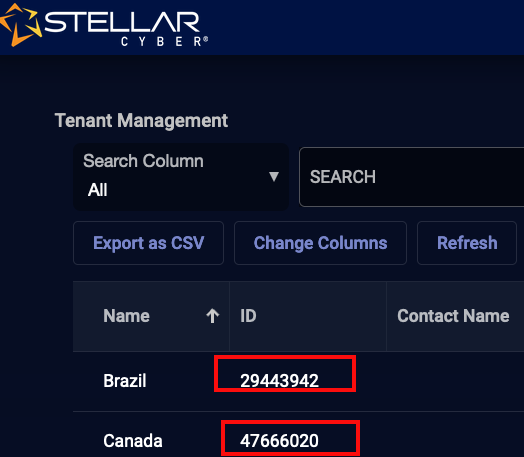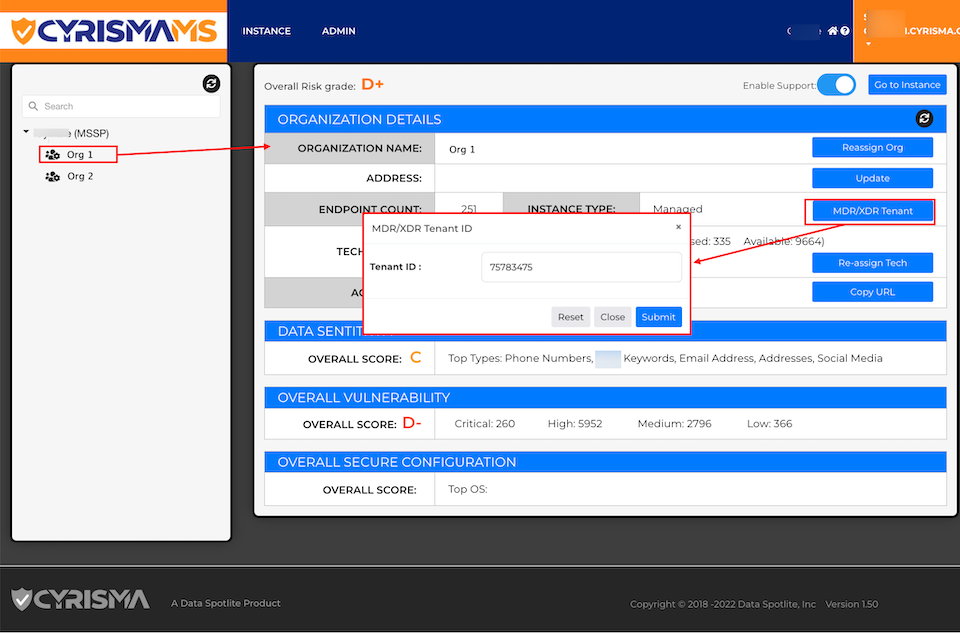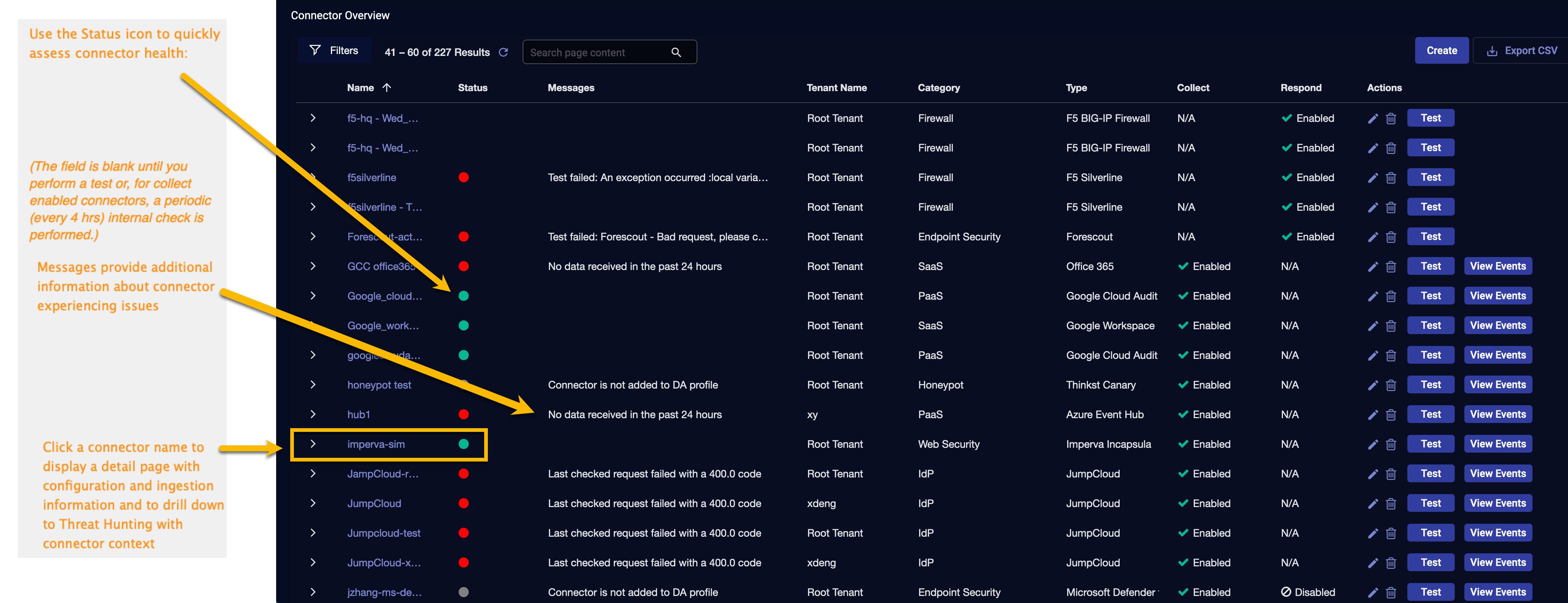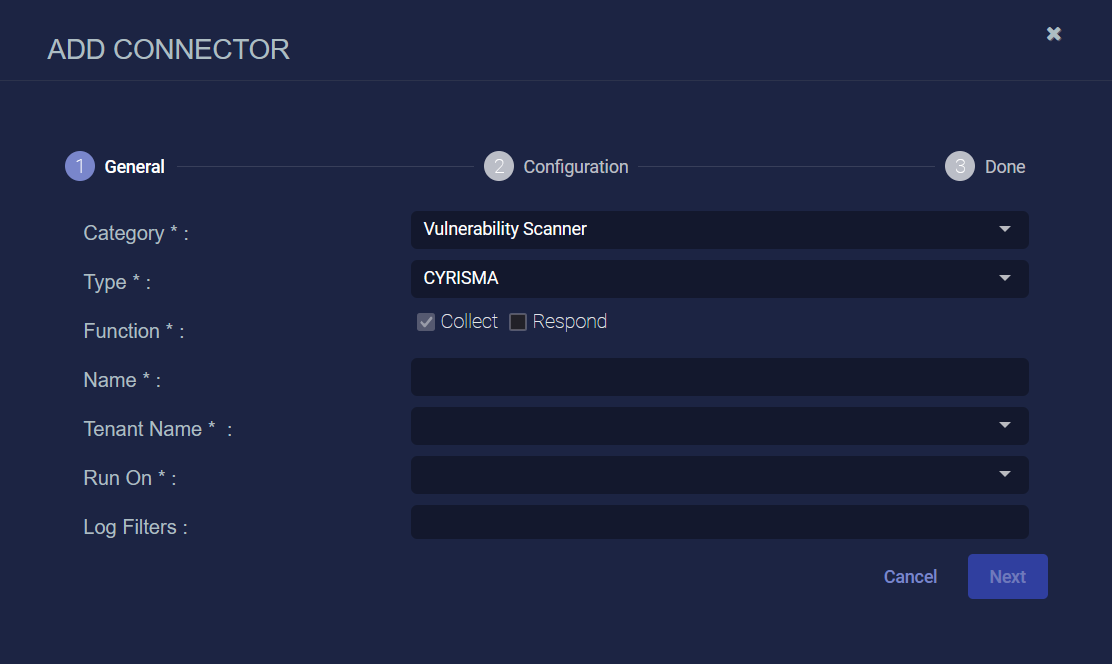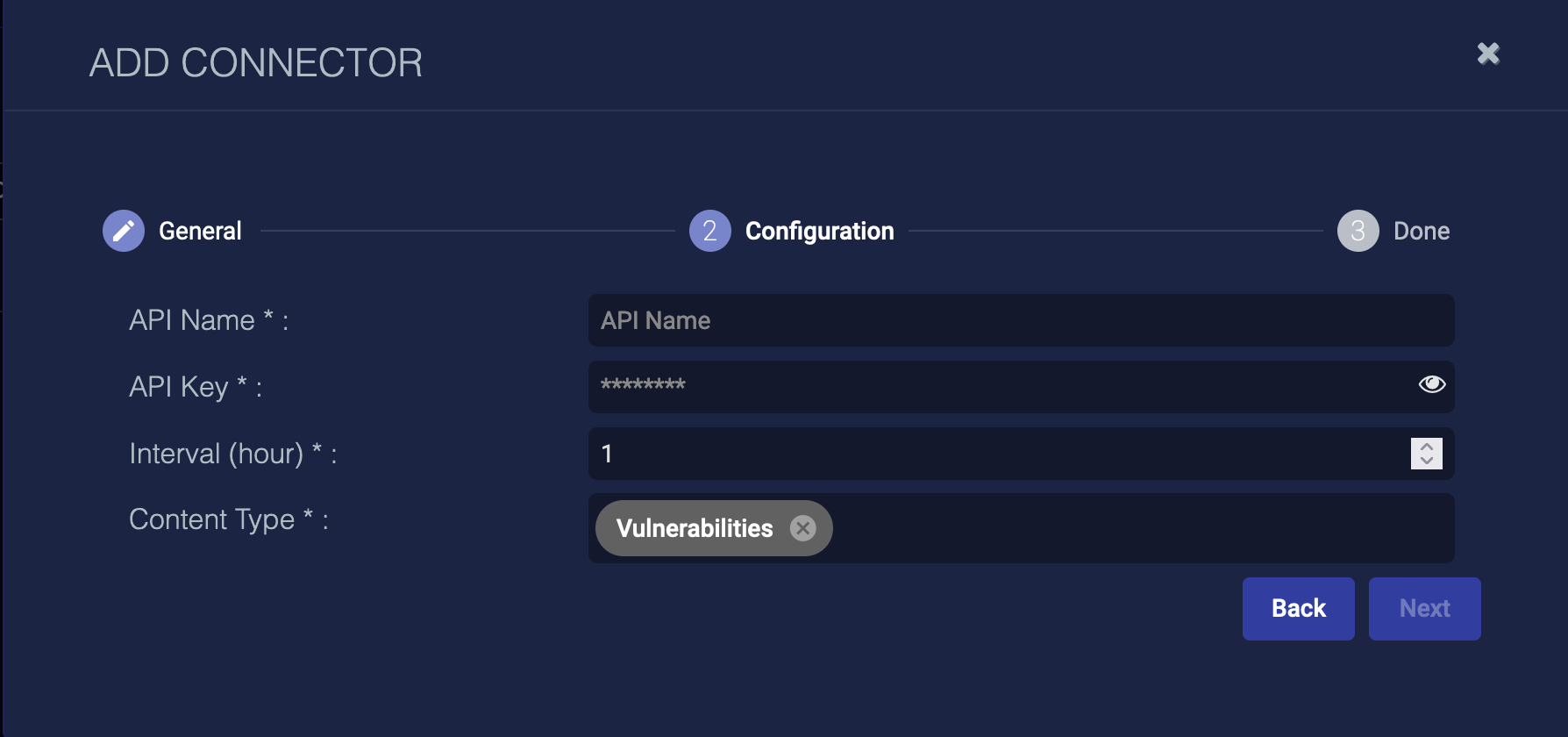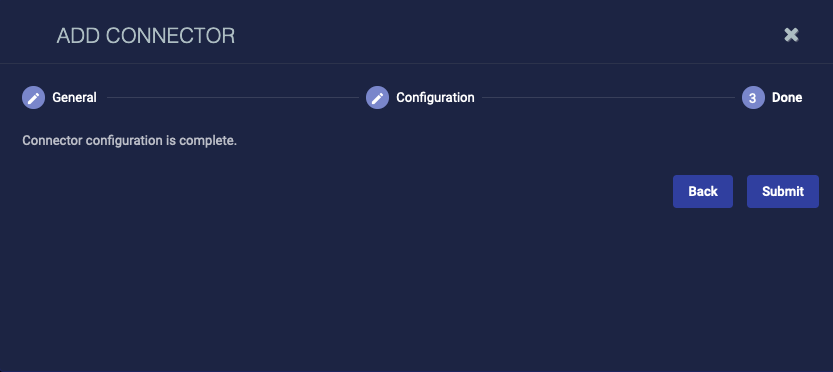Configuring CYRISMA Connectors
Connectors allow Stellar Cyber to collect data from external sources and add it to the data lake. Review the content in this topic to understand what type of data can be collected and acted upon for this connector type.
Stellar Cyber connectors with the Collect function (collectors) may skip collecting some data when the ingestion volume is large, which potentially can lead to data loss. This can happen when the processing capacity of the collector is exceeded.
Connector Overview: CYRISMA
Capabilities
-
Collect: Yes
-
Respond: No
-
Native Alerts Mapped: No
-
Runs on: DP
-
Interval: Configurable
Collected Data
|
Content Type |
Index |
API |
|---|---|---|
|
Vulnerabilities |
Syslog, Linux |
https://msp.cyrisma.com/app/vulnerability/report/tenants (fetches tenant IDs, tenant access URL, and temporary access token) https://tenant_access_url/app/vulnerability/report/json (fetches vulnerabilities) |
|
Hosts |
Syslog, Assets |
Automatically extracted with Vulnerabilities |
Domain
|
https://msp.cyrisma.com/ https://<customer_instance_URL>.cyrisma.com |
The <customer_instance_URL> is not provided in the configuration of this connector, but is returned from previous API calls.
Response Actions
N/A
Third Party Native Alert Integration Details
N/A
Required Credentials and Configurations
-
API Name and API Key
Locating Records
Use the following to query for records:
-
msg_origin.source:
cyrisma -
msg_origin.vendor:
cyrisma -
msg_origin.category:
security_scan -
msg_class:
cyrisma_host,cyrisma_vulnerability
Adding a CYRISMA Connector
To add a CYRISMA connector:
- Obtain credentials and prepare CYRISMA
- Add the connector in Stellar Cyber
- Test the connector
- Verify ingestion
Obtaining Credentials and Preparing CYRISMA
CYRISMA is a SaaS service with MSSP accounts managing data for multiple organizations. Each organization is considered a “tenant” to Stellar Cyber.
Set up one connector for each CYRISMA tenant from which you want to pull data.![]()
To support this connector configuration and function:
-
Obtain the MSSP API Name and API Key: These are provided to the MSSP by CYRISMA Customer Support.
-
Add Stellar Cyber Tenant IDs: For any organization that the MSSP wants to retrieve data from CYRISMA, the MSSP must do the following:
-
Set up a tenant in Stellar Cyber corresponding to each of the organizations in CYRISMA for which they want to collect data.
-
Access the Stellar Cyber Tenant screen and make note of the ID number associated with each of the organizations.
-
Access the CYRISMA console (https://msp.cyrisma.com).
-
Display each organization page and locate the field labeled MDR/XDR Tenant, as shown below.
-
Click the field and add the tenant ID you obtained from Stellar Cyber.
-
Adding the Connector in Stellar Cyber
To add the CYRISMA connector in Stellar Cyber:
-
Log in to Stellar Cyber.
-
Click System | Connectors (under Integrations). The Connector Overview appears.
-
Click Create. The General tab of the Add Connector screen appears. The information on this tab cannot be changed after you add the connector.
The asterisk (*) indicates a required field.
-
Choose Vulnerability Scanner from the Category drop-down.
-
Choose CYRISMA from the Type drop-down.
-
For this connector, the supported Function is Collect, which is enabled already.
-
Enter a Name.
Notes:- This field does not accept multibyte characters.
- It is recommended that you follow a naming convention such as tenantname-connectortype.
-
Choose a Tenant Name. The connector will pull data for this tenant. The Interflow records created by this connector include this tenant name.
-
Choose the device on which to run the connector.
-
(Optional) When the Function is Collect, you can apply Log Filters. For information, see Managing Log Filters.
-
Click Next. The Configuration tab appears.
The asterisk (*) indicates a required field.
-
Enter the API Name you obtained from CYRISMA Customer Support.
-
In the API Key you obtained from CYRISMA Customer Support.
-
Enter the Interval (hour). This is how often Stellar Cyber collects information.
Note that the typical interval for connectors is in minutes. The CYRISMA API supports intervals in hours.
-
Choose the Content Type. The logs for Vulnerabilities are supported.
-
Click Next. The final confirmation tab appears.
-
Click Submit.
The new connector is immediately active.
Testing the Connector
When you add (or edit) a connector, we recommend that you run a test to validate the connectivity parameters you entered. (The test validates authentication and connectivity).
For connectors running on a sensor, Stellar Cyber recommends that you allow 30-60 seconds for new or modified configuration details to be propagated to the sensor before performing a test.
-
Click System | Connectors (under Integrations). The Connector Overview appears.
-
Locate the connector by name that you added, or modified, or that you want to test.
-
Click Test at the right side of that row. The test runs immediately.
Note that you may run only one test at a time.
Stellar Cyber conducts a basic connectivity test for the connector and reports a success or failure result. A successful test indicates that you entered all of the connector information correctly.
To aid troubleshooting your connector, the dialog remains open until you explicitly close it by using the X button. If the test fails, you can select the button from the same row to review and correct issues.
The connector status is updated every five (5) minutes. A successful test clears the connector status, but if issues persist, the status reverts to failed after a minute.
Repeat the test as needed.
If the test fails, the common HTTP status error codes are as follows:
| HTTP Error Code | HTTP Standard Error Name | Explanation | Recommendation |
|---|---|---|---|
| 400 | Bad Request | This error occurs when there is an error in the connector configuration. |
Did you configure the connector correctly? |
| 401 | Unauthorized |
This error occurs when an authentication credential is invalid or when a user does not have sufficient privileges to access a specific API. |
Did you enter your credentials correctly? Are your credentials expired? Are your credentials entitled or licensed for that specific resource? |
| 403 | Forbidden | This error occurs when the permission or scope is not correct in a valid credential. |
Did you enter your credentials correctly? Do you have the required role or permissions for that credential? |
| 404 | Not Found | This error occurs when a URL path does not resolve to an entity. | Did you enter your API URL correctly? |
| 429 | Too Many Requests |
This error occurs when the API server receives too much traffic or if a user’s license or entitlement quota is exceeded. |
The server or user license/quota will eventually recover. The connector will periodically retry the query. If this occurs unexpectedly or too often, work with your API provider to investigate the server limits, user licensing, or quotas. |
For a full list of codes, refer to HTTP response status codes.
Verifying Ingestion
To verify ingestion:
-
Click Investigate | Threat Hunting. The Interflow Search tab appears.
-
Set the Indices to match the type of content you collected:
-
For Vulnerabilities, change the Indices to Scans.
-
For Host data, change the Indices to Assets.
The table immediately updates to show ingested Interflow records.
-
